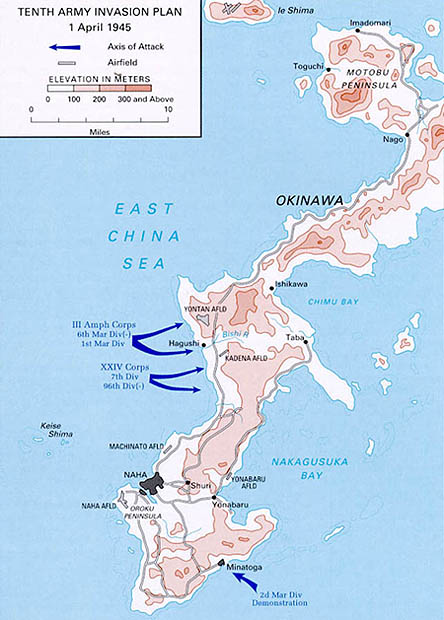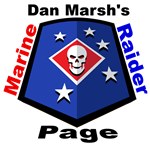Invasion – Resurrection Day
L-Day, which was also Resurrection Day, dawned bright and clear. Company K was aroused (if any one was asleep) long before dawn, and was busy gobbling down steak and eggs and making the usual preparations for an assault.
Then came the hurry up and wait process of loading into the Amtracs, while choking on the exhaust because the bow doors were not open. On schedule, at 0700 the LST’s including ours, began disgorging the LVTA’s as well as the troop carrying LVT’s. Our LVT proceeded quickly to the rendezvous area, where we circled slowly as others joined our group. While in this phase of the landing schedule, we were free to stand up and watch the pre-landing bombardment of the beaches. Soon on signal, we broke out of the rendezvous circle and took our position in the first assault wave. When the wave was aligned as planned, we approached the line of departure and when the control boat dropped the flag began the 4000-yard run to the beach. We had steeled ourselves to expect artillery, mortar and machine gun fire as we approached the beach and heavy resistance once ashore. We looked at one another in unbelief, when the LVT ground to a halt, and we were safely ashore. Company K quickly deployed from the LVT’s, reorganized and began the advance toward the regimental phase line. The 1st and 3rd Battalions made steady progress up the slopes against light resistance. Contact with the 7th Marines on our right was quickly established, and by mid-morning we had reached Yontan Airfield. Following a short pause, we continued the advance across the airfield expecting at any moment to be hit with a hail of mortar and artillery fire. All that we encountered however, was a small amount of sniper fire. The rapid advance of the 4th Marines had opened a gap between our left flank units and those of the 22nd Marines.
Nevertheless, the 4th Marines pressed their attack through the rough, wooded terrain to their front. Several caves were encountered but the tanks that by now were supporting the attack rendered them harmless. Due to the over extension of the 4th Marines lines, 2/4 was released from Division reserve in mid-afternoon to fill the gap between 1/4 and the 22nd Marines.
The overall advance along the beachhead line continued until early evening. Then all units, including the 4th Marines, established defensive positions and patrolled to their front. By nightfall the 6th Marine Division was ready and able to continue the assault in the morning. The 29th Marines (Corps reserve) was ashore and located near Hanza in the zone of the 22nd Marines. On L-Day the 10th Army had established a beachhead, 15,000 yards wide and 4000-5000 yards in depth, within eight hours.
Following a quiet night, the 4th Marines resumed their advance about 0730 across very rugged ground. Resistance was scattered at first, but as the day progressed areas of stiff resistance were being encountered. In late morning, our battalion (¾ ) uncovered a strong enemy position with mutually supporting fire from both sides of a ravine. This strongpoint was in L Company’s zone, which they finally reduced utilizing an enveloping movement. During the afternoon ¼ encountered a similar strongpoint, which they destroyed with the support of a platoon of tanks. During the day’s operations the two Battalions killed over 250 Japanese before digging in for the night beyond the L-3 line at 1830.
The assault continued on 3 April along the 6th Division front. Both the 22nd and 4th Marines met little resistance as they advanced up to 7000 yards over very difficult terrain. The high ground over looking Yontan was secured and the Division objective beyond the hill mass as well. The assault was halted around 1700, with ¼ tied in with the 1st Division on the right. With all restrictions on movement removed by General Buckner, the Sixth Division pressed the attack vigorously on 4 April. The 4th Marines met no resistance in their advance to the L+15-phase line before noon. Then the regiment was ordered to push beyond that line to a newly assigned Division objective. By the time a halt had been called, and defensive positions established, the Division had advanced over 7500 yards. Their lines extended across the Isthmus from south of Yakada on the West Coast to Yaka on the east. The terrain was becoming increasingly rugged and broken with many ravines and steep valleys. For the present, that was the limiting factor in their drive northward. During the rapid advance, 3/22 had reached Ishikawa before noon, which pinched out the 4th Marines who also had reached the East Coast. Colonel Shapley was ordered to reorganize in the Ishikawa area and prepare to support either flank in the advance northward.
Two armor-supported infantry columns were launched in the morning to make an extended reconnaissance up both sides of the Isthmus. The Recon. Company was on the left, (west) flank and F Company 4th Marines on the right. Company F advanced 14 miles before retracing their steps in the afternoon. The only opposition they encountered was when they entered Chimu, where two Japanese were killed and a fuel tank destroyed. The drive up the west side was uneventful and the patrol returned to it’s lines that evening.
The assault battalions followed the mobile columns, and over very difficult ground gained approximately 7000 yards. When forward movement ceased, the 22nd marines were on a line extending from Atsutabaru to Chimu, with 2/4 and ¾ closed up to the rear ready to pass through in the morning.
On 6 April the 4th Marines and 29th marines passed through the 22nd’s lines to continue the drive up the peninsula. The 22nd then reverted to Division reserve. Since there were only a few roads into the interior, the plan was to advance in a column of battalions with patrols dispatched to secure roads and trails. As the lead Battalion was depleted, the next battalion would pass through, and the advanced continued by the leap frogging of Battalions. When the Regiment halted for the night, 7 miles had been gained and only a few stragglers encountered.
Operations of the 4th Marines resumed in the morning, with the Battalions in trace as follows; three, one and then two. The advance was almost a re-run of the preceding day. Only the rugged terrain, terrible roads and inadequate enemy defense measures hindered the leapfrogging tactics. An attached platoon of Engineers, cleared clumsy roadblocks, removed mines and built by passes around demolished bridges. Despite these delays the 4th Marines had gained another 7 miles by late afternoon. Just north of Ora ¼ set up a perimeter with it’s flanks anchored on the coast, while the 2nd and 3rd battalions established separate defensive perimeters along the road.

When the advance of the Division to the north uncovered the base of Motobu Peninsula, General Shepherd ordered a general re-alignment of the Division. Aerial photo studies and reports from civilians had confirmed reports that the enemy had concentrated his northern forces in the mountains of Motobu Peninsula. The 29th Marines were to advance on Motobu to locate the enemy strongpoints and the nature of their fortifications. The 22nd Marines moved out of reserve and took up positions extending across the Island from Nakaoshi to Ora guarding the right flank of the 29th. The 4th Marines were in positions near Ora where they could support the advance on Motobu or continue the attack to the north.
Apr. 9-12: Both the 4th and the 22nd Marines sent out patrols the next few days, to search the interior and the north, while the 29th moved to clear the Peninsula of the enemy. During this period patrols of the 4th marines probed all the area within a 3000-yard radius of their perimeters. Then on the 12th 3/4 was ordered to re-locate to Kawada the following day.
However, on the 10th Company K was dispatched on an extended patrol up the East Coast. It was during this patrol that I wondered if Capt. Sexton was a relative of Stonewall Jackson. Our search of the area was thorough, but also rapid like Stonewall’s "foot cavalry." Since we were near the coast we relied on Amtrac’s for resupply and support as needed. In one week we penetrated 28 miles up the northern coast. On the 18th, if my memory is correct, we made contact with a patrol sent out by the 22nd after they had reached Misaki the northern tip of Okinawa.
